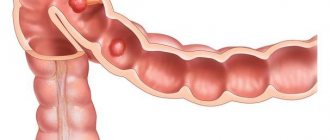Colostomy is a surgical procedure during which a section of the colon is brought out through an opening in the abdominal wall and a colostomy is formed - an opening for the passage of stool, mucus and gases. This operation is performed for various diseases of the colon and rectum. It is often necessary to resort to it in cancer patients.
The colon is part of the large intestine. Water and some nutrients are absorbed in it, feces are formed, which then enter the sigmoid colon and rectum, and are evacuated out through the anus (anus).
If the function of the colon, rectum and anus is impaired, the evacuation of feces becomes very difficult or completely impossible. This is precisely the problem that a colostomy solves. The surgeon creates an artificial opening that temporarily or permanently takes over the functions of the anus.
Indications
The purpose of creating an artificial opening is to exclude the direct part of the digestive organ from the process of fecal excretion. Conditions for which an intestinal stoma is performed are:
- fecal incontinence due to problems with the anal sphincter;
- mechanical injuries of the rectum;
- pathologies of the gastrointestinal tract in the area of the colon that are at the stage of decompensation (diverticulitis, polyposis, ischemic colitis, abscess formation of the walls of the organ, etc.);
- an indication for ostomy may be recurrent oncology of the urinary or pelvic organs;
- the presence of fistulous tracts of the rectum;
- congenital anomalies (atresia of the rectum or anal sphincter);
- A colostomy for cancer is imposed due to stenosis of the lumen of the underlying part of the organ by the tumor.
A colostomy may also be performed in preparation for surgery on the large intestine.
Constipation after stoma closure. Frequent bowel movements after iliostomy closure
Consultation
Good afternoon.
In April 2020, I underwent surgery for cancer of the rectosigmoid colon pT2N0M0, stage 1, clinical group 3. A loop iliostomy was performed. Complication, tumor stenosis of the rectosigmoid colon, grade 1. Parascopically assisted anterior rectal resection operation.
Three months later, I underwent all the tests to perform a reconstructive colonic anastomosis and, accordingly, close the iliostomy.
From the FCS they diagnose severe catarrhal colitis and anastomositis. The anastomosis was placed 10 cm from the anus, 2.5 cm in diameter is freely passable, the mucous membrane is hyperemic. The tone of the intestinal wall is not reduced, peristalsis is observed, haustration is pronounced, sphincter tone is preserved, and no neoplasms are observed in the anal canal or rectum.
On July 19, 2020, intra-abdominal closure of the iliostomy was performed.
Classification
The types of colostomies are determined by the time and location of their application. Let's talk about these criteria in more detail.
By time
First of all, it should be noted that a colonostomy is imposed both for a certain period of time and for life. Based on this, it has the following varieties:
- Temporary This type is carried out in the presence of inflammatory and other pathological processes in the rectum, which resolve over time with the help of treatment. After eliminating the disease, the colostomy is sutured, and the digestive organ is put back into operation.
- Permanent This type of colostomy is in most cases performed for rectal cancer at the last stage. The patient lives with a specially made hole all his life.
By localization
Depending on the part of the intestine that is excreted, there is the following classification of colostomies:
- Transverse This type involves the removal of the transverse colon section of the intestine onto the anterior abdominal wall. It is installed for pathologies located below this area of the organ and happens:
- single-barrel colostomy (end) – most often performed when lower parts of the intestine are removed due to oncology;
- double-barreled colostomy - in most cases, it is applied temporarily and has two holes, the first of which is necessary for the evacuation of feces, and the second for the administration of medications.
- Ascending Superimposed on the ascending part of the digestive tract. Since stool has not yet formed in this area, loose stool will be expelled.
- Descending It is carried out in case of a pathological process in the rectosigmoid region of the intestine. The advantage of this type of stoma is partial control of stool elimination; this is explained by the presence of sensitive receptors in this area.
Rectal cancer: causes
1. Food addictions. This is one of the most important factors influencing the development of the disease. Favorable conditions for the appearance of cancer are created by consuming an abundance of meat, baked goods, fatty foods, as well as a low content of vegetables, fruits, and whole grains in the menu.2. Constipation3.
Diseases of the colon, such as the presence of polyps or
colitis4.
Genetic predisposition.
Advanced age.
Now let's take a closer look at each of these factors.
When eating fatty and meat foods, fatty acids are released into the intestines, which are converted into carcinogens. Quite rarely, residents of regions that prefer plant foods, such as India or Africa, suffer from this disease. Some carcinogens are formed in food during certain types of cooking, such as smoking. With frequent contact of epithelial cells with these substances, in some places the cells degenerate into malignant ones.
With constipation, all these harmful substances are not evacuated from the body in time and act longer on the mucous membrane, provoking cell mutations.
Of all chronic diseases of the large intestine, ulcerative colitis is the most dangerous. When colitis lasts up to five years, the likelihood of developing cancer increases by 5%. If colitis is observed for fifteen years, the probability increases by 10–12%. In a patient suffering from colitis for twenty years, the risk of developing the disease increases by a third. Crohn's disease also creates favorable conditions for the development of colon cancer, but here the risk is less and does not exceed 20%.
It is impossible not to mention the hereditary predisposition to this type of cancer. Close relatives of a person with colorectal cancer are also at high risk for this disease. Particular attention should be paid to those who have already been diagnosed with malignant neoplasms of a different location.
Many hereditary diseases, for example, Turcot and Gardner syndromes, diffuse polyposis are also dangerous with a high probability of developing colon cancer. For the above diseases, it is recommended to remove the polyps, and sometimes the entire intestine. Otherwise, there is an almost one hundred percent chance of developing multiple foci of cancer.
If the cancer syndrome is inherited, then this is autosomal dominance and the disease is expressed in the appearance of several adenocarcinomas on the colon mucosa. 30% of such patients develop cancer after age fifty.
Separately, it should be said about the connection between colorectal polyps and cancer development.
The reasons why a person develops colorectal cancer have not yet been identified. It is likely that it occurs as a result of chronic inflammatory processes - proctitis, ulcerative colitis, the appearance of chronic anal fissures. In addition, genetic predisposition has a significant influence.
This includes a family history of colon and rectal cancer and diffuse polyposis. Familial diffuse polyposis is accompanied by the proliferation of polyps. Their number can reach from tens to hundreds of polyps, which take the form of cancer. The cause is a genetic mutation that is inherited. An incorrect diet can also have a negative impact: an excess of fatty and meat foods, a lack of vegetables and grains - all this leads to stool disturbances.
Constipation causes acute irritation of the rectal and colon mucosa through toxic products entering the body and penetrating into the blood. Excessive eating, a sedentary lifestyle and zero exercise activity can lead to excess weight, and as a result, to the formation of tumors in the intestines.
Excessive smoking also leads to cancer, which causes cancer in the digestive system. At the same time, statistics indicate a noticeable decrease in cancer patients among vegetarians. There is a high risk for people whose work is highly hazardous: asbestos production and sawmills.
https://youtu.be/8tluX9ycmuU
Care
A colostomy requires careful care throughout its existence. During the first days in a medical facility, the artificial opening is treated by a medical professional who explains what a stoma is and how to care for it. After discharge, the patient performs the necessary procedures independently.
Colostomy after surgery can be thoroughly treated with antiseptic. This is necessary for its speedy regeneration and prevention of the development of infectious inflammation. The care algorithm varies slightly depending on the stage of healing.
Before healing
How to live with a colostomy in the first days after the intervention? In the early recovery period, the patient undergoes the following treatment algorithm:
- fecal contents are removed from the colostomy lumen;
- the intestinal mucosa is brought out and the skin around it is washed with water; you can use care products such as Cleanser and Conveen Easy Cleans cleaners;
- then the entire area is disinfected with alcohol, the processing algorithm is from the center to the periphery;
- the colostomy itself and the surrounding skin are treated with protective ointments or creams, such as “Barrier”, “Conveen Protact”;
- then a napkin soaked in Vaseline oil is applied to the hole;
- then a piece of aseptic bandage is applied to the napkin;
- To fix the napkins, they are bandaged to the body with a gauze bandage.
Such dressings are changed 6 times a day until the artificial hole heals.
After healing
As the opening for collecting stool heals, the use of a colostomy bag - a special disposable bag - is allowed. At this stage, colostomy care at home will be carried out as follows:
- feces are removed from the colostomy lumen;
- the hole and the skin around it are washed with water or special cleaners, then dried with a napkin;
- the mucous membrane brought out is lubricated with cream, the processing algorithm is in a circular motion from the center to the periphery;
- upon completion of hygiene procedures, a colostomy bag is applied;
- Coloplast paste is used to firmly secure the colostomy bag.
In order to prevent maceration (irritation) of the skin in the area of the colostomy bag, care products such as Coloplast powder and Second Skin protective film are used. Stool collection bags are changed daily in the morning or evening.
Both the patient and his relatives are trained in the technique of treating a colostomy and changing colostomy bags.
The criterion for the formation of a colostomy is the mouth formed from the intestinal mucosa and the absence of signs of inflammation.
Types of colostomy
As already mentioned, a stoma can be
Temporal. Constant.
By localization:
Ascending stoma (ascendostomy). Transverse stoma (transverse stoma). Descending stoma (descendostomy). Sigmostoma.
By shape
Double-barreled (loop) - mostly temporary. Single-barrel (or end) - often permanent.
Diet and lifestyle recommendations
The principles of living with a colostomy include recommendations for combating the non-excretion of feces from the artificial opening, as well as adherence to a diet to prevent digestive disorders.
What to do if you don't pass stool
Living with a colostomy comes with some challenges. There are cases when the evacuation of feces stops through the hole. This may occur due to dietary disturbances, abdominal muscle tension, or slower intestinal motility due to physical inactivity.
When stopping the passage of feces through a colostomy, the following recommendations must be followed:
- a warm shower - this will help relax the muscles of the abdominal wall;
- light massage of the abdomen clockwise or around the artificial opening;
- simple exercises - bringing the legs to the stomach or standing in the knee-elbow position (reduce intra-abdominal pressure).
For constipation lasting more than 6 hours, they resort to cleansing enemas - with a colostomy, such procedures are carried out using a thick gastric tube or a special tip.
Diet
Nutrition during a colostomy does not imply adherence to a strict specialized diet, but only some dietary features to prevent various digestive disorders.
The basic principles of nutrition after intestinal surgery are:
- exclude foods that increase gas formation in the intestines - carbonated drinks, legumes, fresh cabbage, whole milk;
- foods that enhance the smell of feces are limited - spicy vegetables (onions, garlic, radishes), eggs, fish, spices;
- for digestive disorders with a predominance of diarrhea, it is recommended to include in the diet foods rich in plant fiber - vegetables, raw fruits;
- constipation is an indication for the consumption of liquid, pureed food; It is important to maintain a drinking regime.
A diet for a colostomy involves frequent and small meals, as well as chewing them thoroughly.
SWEET FLOUR DISHES
Recommended: oatmeal (rolled oats);
rice, semolina, meat broth with dumplings, noodles, meatballs, rice, pancakes; potato soup, vegetable soups (puree). Not recommended: soups made from legumes, from cabbage, from dried vegetables, from concentrates.
Recommended: beef, veal, lean pork, lean ham, poultry, rabbit, soft smoked meats, offal - liver, brains; language.
The meat can be boiled, stewed, fried or sometimes fried.
Not recommended: goose, duck, game, offal, smoked meat, stew.
Recommended: lean, boiled, baked fish; on a spit - trout, perch, fresh cod, flounder, canned fish in its own juice.
Not recommended: fatty fish, canned fish, fish in sauce or marinade; tuna, salmon, eel, mackerel, herring, sardines, anchovies; any crustaceans.
Recommended: made from biscuit or butter dough, cream puddings, mousses, butter creams, homemade cakes, babas, muffins, omelettes, low-fat shortbread dough.
Not recommended: too fatty, heavy desserts, sweet dishes made from fresh yeast dough, donuts.
Colostomy operations
Surgery offers two main types of surgical interventions, the purpose of which is the formation or closure of a colostomy.
Colostomy
Colostomy surgery is performed in a hospital setting under general anesthesia. A colostomy is performed as follows:
- at the site of the supposed hole, a rounded area of the skin and underlying tissue is removed;
- then the muscles are cut to gain access to part of the intestine;
- remove part of the intestine;
- make an incision in the intestine;
- The walls of the organ are sewn to the muscle layer, and the edges are sewn to the skin of the abdomen.
The choice of one type of colostomy or another depends on the reason that led to the operation.
Closing the colostomy
The closure of the colostomy is carried out if the underlying section of the intestine is ready to be included in the work of digestion, that is, all inflammatory and other pathological processes have been eliminated. This operation is carried out 2-6 months after the formation of an artificial hole, where the essence of the intervention is its elimination.
This operation is carried out as follows:
- the mucous membrane of the excreted intestine is gradually cut off from the skin;
- the intestine is taken out, the previously sutured part is resected;
- then the ends of the intestines are stitched together;
- part of the intestine is placed back into the abdominal cavity.
At the end of the operation, a suture is formed by layer-by-layer stitching of tissues - muscles, fatty tissue and skin. The wound heals by primary intention using ligature threads or self-absorbing staples.
A little history
The method of performing ileostomy appeared much later than colostomy, but immediately showed the importance of such operations. The first operation to remove an ileostomy was performed in 1879 by Baum on a cancer patient who had a blockage of the ascending colon due to a cancerous intestinal tumor. Baum brought the colon out onto the abdominal wall and formed an ileostomy, allowing the intestines to heal on their own.
The first operations had many disadvantages. After removing the ileostomy using this method, serositis (inflammation of the serous membrane) constantly appeared, and a huge amount of liquid substance poured out of the small intestine. And the mucous membrane fused with the skin only after a long period, when the intestines finally adapted to its new state.
A new step in the history of the development of surgery was the proposed Thornbull ileostomy technique. He realized that the outer lining of the intestine could not withstand the influence of the external environment, and tried to cover the exposed part of the intestine with a piece of skin. The technique for performing such an operation was complicated, but the problem of intestinal adaptation was solved.
But the most successful was Dr. Brook's proposal, although quite controversial. According to his method, the intestine was everted and the inner mucous membrane was sutured to the skin. This operation was easy to perform, and most importantly, it greatly reduced the period of intestinal adaptation after the operation.
Complications
Can complications develop after a colostomy? With irrational care of the hole, many conditions arise that are associated with the formation of infectious inflammation or an unfavorable outcome of surgical intervention.
Among them are:
- abscess formation of tissue around the hole;
- development of necrosis of the part of the organ brought out;
- retraction of the intestine due to non-compliance with the rules of the recovery period;
- straightening part of the intestine outward;
- stenosis of the intestinal lumen due to scarring after surgery;
- eventration – prolapse of a loop of intestine.
In addition, with improper care, maceration of the skin may occur due to its excessive moisture. This problem is manifested by itching, redness and minor rashes.











